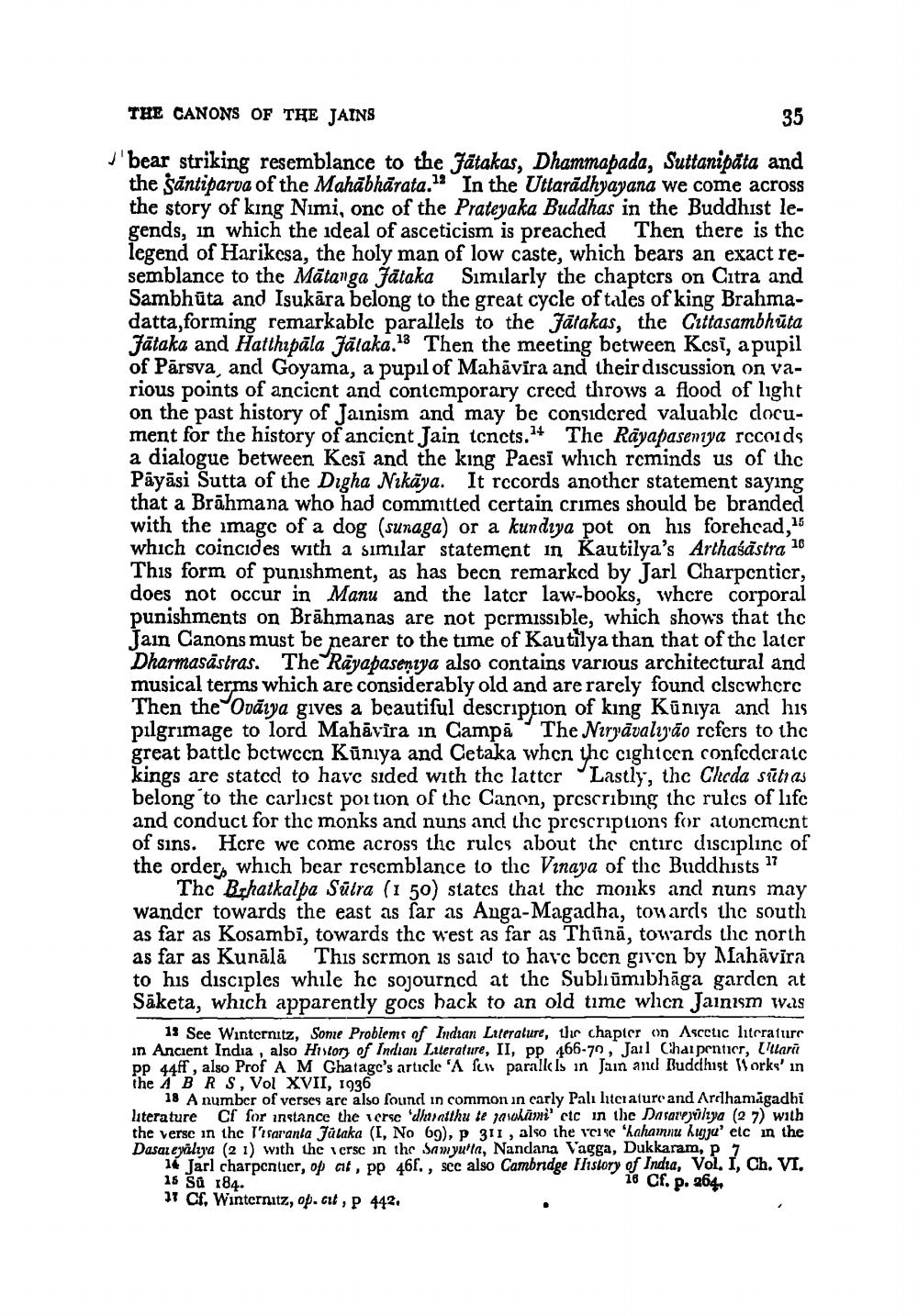________________
THE CANONS OF THE JAINS
35
'bear striking resemblance to the fätakas, Dhammapada, Suttanipäta and the sāntiparua of the Mahābhārata. In the Uttaradhyayana we come across the story of king Nimi, onc of the Prateyaka Buddhas in the Buddhist legends, in which the ideal of asceticism is preached Then there is the legend of Harikcsa, the holy man of low caste, which bears an exact resemblance to the Mātanga Jataka Similarly the chapters on Cıtra and Sambhūta and Isukāra belong to the great cycle of tales of king Brahmadatta,forming remarkablc parallels to the Jātakas, the Cittasambhūta Jataka and Hatthipāla Jālaka.13 Then the meeting between Kcsi, a pupil of Pārsva, and Goyama, a pupil of Mahāvīra and their discussion on various points of ancient and contemporary crecd throws a flood of light on the past history of Jainism and may be considered valuable document for the history of ancient Jain tcncts.14 The Rayapaseniya rccoids a dialogue between Kesi and the king Paesi which reminds us of the Payāsi Sutta of the Digha Nikāya. It records another statement saying that a Brāhmana who had committed certain crimes should be branded with the image of a dog (sunaga) or a kundiya pot on his forehead,15 which coincides with a similar statement in Kautilya's Arthaśāstra 10 This form of punishment, as has been remarked by Jarl Charpentir, does not occur in Manu and the later law-books, where corporal punishments on Brāhmanas are not permissible, which shows that the Jain Canons must be nearer to the time of Kautilya than that of the later Dharmasastras. The Rāyapaseniya also contains various architectural and musical terms which are considerably old and are rarely found clscwhere Then the Ovāıya gives a beautiful description of king Kūniya and his pilgrimage to lord Mahāvīra in Campā The Niryāvaliyão refers to thc great battle between Kūniya and Cetaka when the cightcen confcdcratc kings are stated to have sided with the latter Lastly, the Chcda stitas belong to the carlicst portion of the Canon, prescribing the rulcs of life and conduct for the monks and nuns and thc prcscriptions for atoncment of sins. Here we come across the rules about the entirc discipline of the order, which bear resemblance to thc Vinaya of the Buddhists 17
Thc Bchatkalpa Sutra (1 50 states that thc monks and nuns may wander towards the east as far as Anga-Magadha, towards the south as far as Kosambi, towards the west as far as Thünā, towards the north as far as Kunālā This scrmon is said to have been given by Mahāvīra to his disciples while he sojourncd at the Subliūmibhāga garden at Sāketa, which apparently gocs hack to an old time wlicn Jainism was
13 See Winternitz, Sonie Problems of Indian Literature, the chapter on Ascetic literature in Ancient India , also History of Indian Literature, II, pp. 466-70, Jail Charpentier, V'llari PP 44ff, also Prof A M Ghatagc's article 'A few parallels in Jain and Buddhist Works' in the A BRS, Vol XVII, 1936
18 A number of verses are also found in common in carly Palı litcrature and Ardhamăgadhi literature Cf for instance the verse dhuratthu te zavolani' ctc in the Dasarvyyliya (27) with the verse in the t'i saranla Jalaka (I, No 69), p 311, also the ci hahamnu huga' etc in the Dasareyalıya (21) with the crsc in the Samyulla, Nandana Vagga, Dukkaram, P7
14 Jarl charpentier, op af, pp 46f. , scc also Cambridge Fristory of India. Vol. I. Ch. VI. 15 Sû 184.
18 Cf. p. 264 17 Cf, Winternitz, op. cut, P 442.




